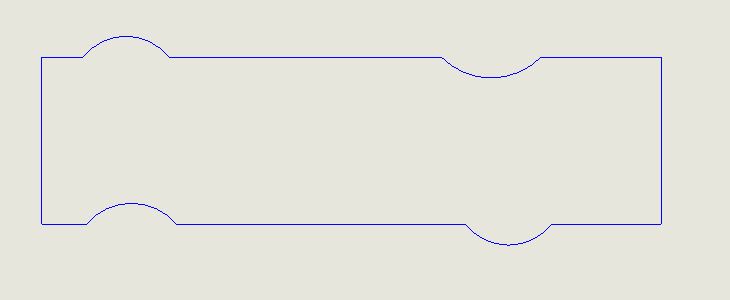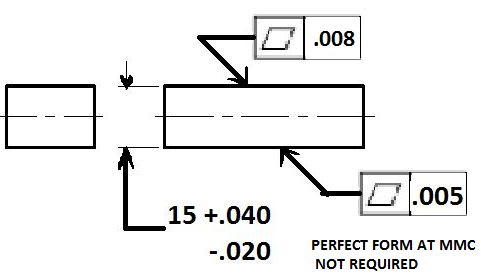Navigation
Install the app
How to install the app on iOS
Follow along with the video below to see how to install our site as a web app on your home screen.
Note: This feature may not be available in some browsers.
More options
Style variation
-
Congratulations MintJulep on being selected by the Eng-Tips community for having the most helpful posts in the forums last week. Way to Go!
You are using an out of date browser. It may not display this or other websites correctly.
You should upgrade or use an alternative browser.
You should upgrade or use an alternative browser.
Flatness on both sides of a feature of size
- Thread starter Kedu
- Start date
- Status
- Not open for further replies.
CheckerHater
Mechanical
15.043

"For every expert there is an equal and opposite expert"
Arthur C. Clarke Profiles of the future
"For every expert there is an equal and opposite expert"
Arthur C. Clarke Profiles of the future
I'll take a stab at it.
15 + .040 (max size tolerance) + .005 (limiting form tolerance) = 15.045
I figure the max form error that results in the maximum envelope is limited to the bottom surface at .005 as any additional form error of the top surface past that (in such a way as it would expand the maximum envelope) would violate the max allowable local size of 15.040
Edit: I should clarify - I mean that in my stack both top and bottom surfaces would have .005 form error. Imagine a banana shape (or two concentric arcs) with constant cross section of 15.040
Edit: Math/numbers - I can't win today!!!
15 + .040 (max size tolerance) + .005 (limiting form tolerance) = 15.045
I figure the max form error that results in the maximum envelope is limited to the bottom surface at .005 as any additional form error of the top surface past that (in such a way as it would expand the maximum envelope) would violate the max allowable local size of 15.040
Edit: I should clarify - I mean that in my stack both top and bottom surfaces would have .005 form error. Imagine a banana shape (or two concentric arcs) with constant cross section of 15.040
Edit: Math/numbers - I can't win today!!!
Here is how i approach it:
1. First i draw a rectangle of perfect form, at the maximum width 15.04, uniform along it's full length.
2. I add a local bulge on the bottom surface at maximum height allowed by it's flatness control - .005. To compensate for it and maintain the maximum local size, the top surface needs an opposite cavity, also of depth .005. So far the envelope is is 15.04+.005=15.045.
3. Now i add a bulge on the top surface. Since i know that the bottom surface will need to compensate for it with a cavity limited by it's flatness, i can only add a bulge of .005 height. The resulting final envelope is: 15.04+.005+.005 = 15.05.
I may be wrong there, but that is my current line of thought.
1. First i draw a rectangle of perfect form, at the maximum width 15.04, uniform along it's full length.
2. I add a local bulge on the bottom surface at maximum height allowed by it's flatness control - .005. To compensate for it and maintain the maximum local size, the top surface needs an opposite cavity, also of depth .005. So far the envelope is is 15.04+.005=15.045.
3. Now i add a bulge on the top surface. Since i know that the bottom surface will need to compensate for it with a cavity limited by it's flatness, i can only add a bulge of .005 height. The resulting final envelope is: 15.04+.005+.005 = 15.05.
I may be wrong there, but that is my current line of thought.
semiond,
You had me till #3. It seems to me at #2 you were at .005 form error top and bottom already then when you moved to #3 you added another .005 to each surface which would be .010 form error at both the top and bottom surfaces, which violates the tolerance applied.
You had me till #3. It seems to me at #2 you were at .005 form error top and bottom already then when you moved to #3 you added another .005 to each surface which would be .010 form error at both the top and bottom surfaces, which violates the tolerance applied.
I figured you weren't violating local size - its the form error that is exceeded. I assume you mean a shape like the below? Even still - if you go .005 in one direction and .005 in the other on the same surface you're still at .010 total which is outside the allowed form tolerance.


CH,
I'm interested to see your reasoning? I'm trying to think why a larger form tolerance on one surface would result in an envelope smaller that 15.045 - I would think the smallest form tolerance limits the max envelope in this case, not the largest.
I'm interested to see your reasoning? I'm trying to think why a larger form tolerance on one surface would result in an envelope smaller that 15.045 - I would think the smallest form tolerance limits the max envelope in this case, not the largest.
CheckerHater
Mechanical
chez,
Don't worry, I changed my mind by now.
"For every expert there is an equal and opposite expert"
Arthur C. Clarke Profiles of the future
Don't worry, I changed my mind by now.
"For every expert there is an equal and opposite expert"
Arthur C. Clarke Profiles of the future
Looks like flatness within .008 has no influence on the extreme bounday BOUNDARY.
Should we assume that the smallest value for flatness is the one used to be added to the maximum thickness regardless of the size tolerance value of the plate thickness ?
In other words if the thickness would be 15 +.0004, -.0002 the maximum envelope calculation / extreme boundary stays the same: 15 + 0.0004 + 0.005 (again just the calculation concept, not the result)?
Should we assume that the smallest value for flatness is the one used to be added to the maximum thickness regardless of the size tolerance value of the plate thickness ?
In other words if the thickness would be 15 +.0004, -.0002 the maximum envelope calculation / extreme boundary stays the same: 15 + 0.0004 + 0.005 (again just the calculation concept, not the result)?
greenimi,
I think I understand what you're asking. Basically you're wondering even if the form tolerance is larger than the size tolerance if the maximum envelope is still dictated by the smallest form tolerance in this case - right? The answer would be yes.
Think about it this way - no matter the size tolerance applied, if the note "perfect form at MMC not required" is included on a feature with no form tolerance applied the maximum envelope is now technically infinite, right? And even though size tolerances have to be finite (obviously - just a thought experiment here) they have no effect on the allowable form error and do nothing to limit the maximum envelope when no form tolerance is applied. So any form tolerance applied, even if greater than the size tolerance, will limit that maximum envelope proportional to the smallest form tolerance applied to the feature. In this case I think the question was worded the way it was to trick us into thinking the .008 tolerance on the top surface changed the maximum envelope vs. the .005 tolerance on the bottom surface even though it is the smallest form tolerance that limits this envelope.
I think I understand what you're asking. Basically you're wondering even if the form tolerance is larger than the size tolerance if the maximum envelope is still dictated by the smallest form tolerance in this case - right? The answer would be yes.
Think about it this way - no matter the size tolerance applied, if the note "perfect form at MMC not required" is included on a feature with no form tolerance applied the maximum envelope is now technically infinite, right? And even though size tolerances have to be finite (obviously - just a thought experiment here) they have no effect on the allowable form error and do nothing to limit the maximum envelope when no form tolerance is applied. So any form tolerance applied, even if greater than the size tolerance, will limit that maximum envelope proportional to the smallest form tolerance applied to the feature. In this case I think the question was worded the way it was to trick us into thinking the .008 tolerance on the top surface changed the maximum envelope vs. the .005 tolerance on the bottom surface even though it is the smallest form tolerance that limits this envelope.
- Thread starter
- #15
- Status
- Not open for further replies.
Similar threads
- Replies
- 25
- Views
- 3K
- Question
- Replies
- 6
- Views
- 10K
- Locked
- Question
- Replies
- 16
- Views
- 5K
- Locked
- Question
- Replies
- 20
- Views
- 9K
- Locked
- Question
- Replies
- 8
- Views
- 4K


![[thumbsup2] [thumbsup2] [thumbsup2]](/data/assets/smilies/thumbsup2.gif)